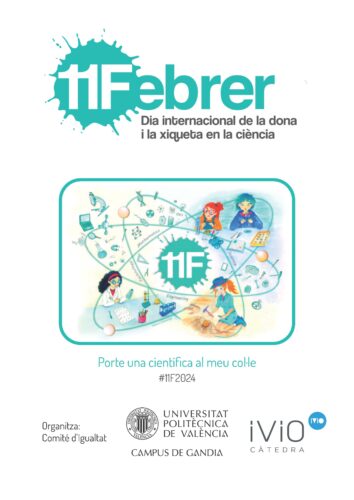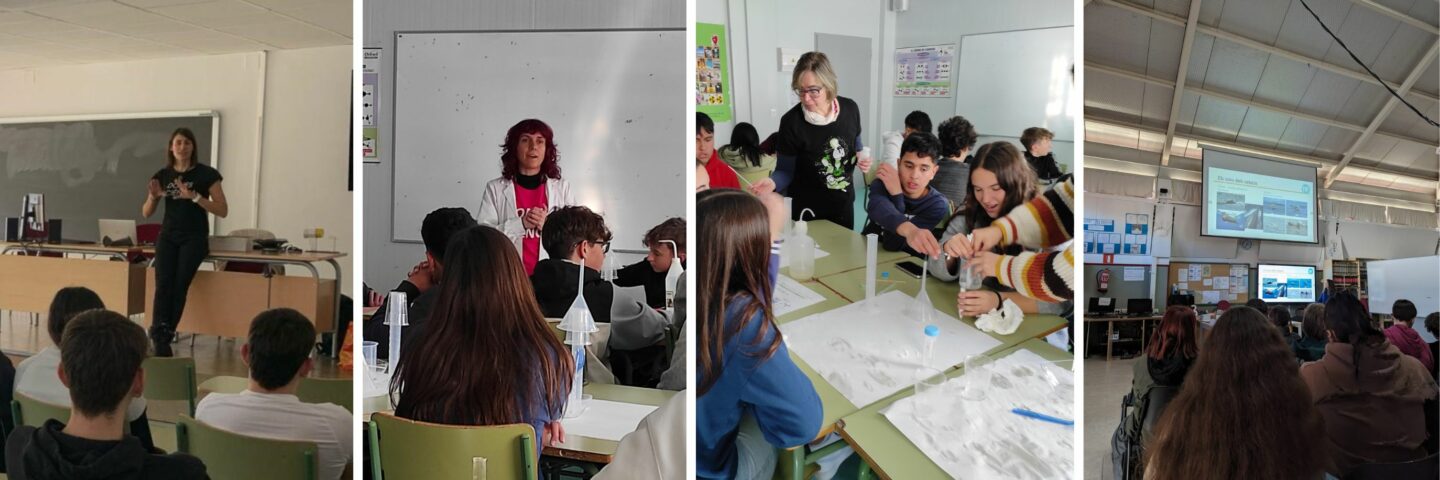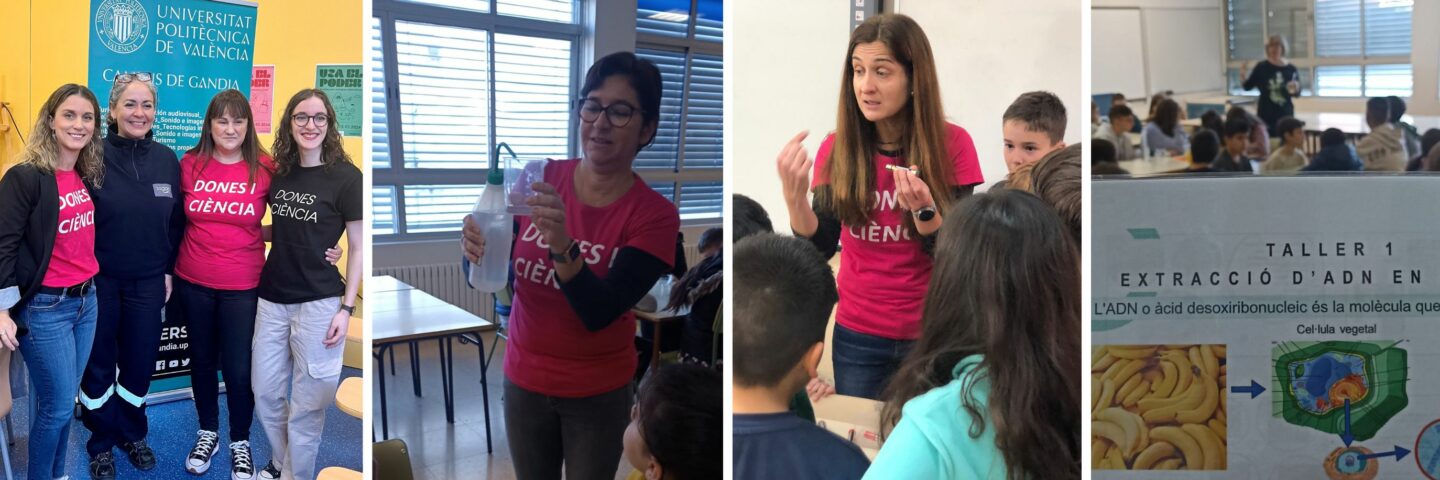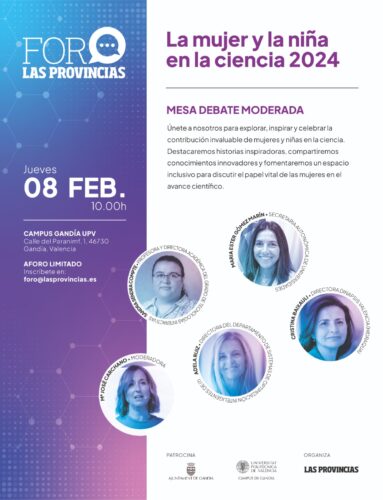For the sixth year in a row, the Equality Committee of Campus Gandia of the Universitat Politècnica de València (UPV) is organizing “Bring a Female Scientist to School” in celebration of 11F International Day of Women and Girls in Science. The activities are set to take place during the month of February as part of a national campaign, with the support of the IVIO Chair.

Recognizing and promoting the achievements of women scientists continues to be a pending subject in the classroom, where there is still a lack of female role models to inspire girls and teens and to see their reflections. This is a key factor to overcoming gender stereotypes that persist in our society and that influence the choices and projections that girls make in their future careers.
According to the Report of the Ministry of Science and Innovation (Women Scientists in Numbers 2023), in the classrooms there is a higher representation of women in health sciences, but a very low representation in engineering (around 25% of the total number of these students are women).
In terms of different branches of study, women continue to represent the majority of enrollment in Master’s Degrees in Health Sciences (71.8%), while only representing one in three of enrollment in Engineering and Architecture (29.9%). The same differences are replicated in the breakdown by sex and branch of study in undergraduate degrees.
The percentage of women and men is practically the same in Doctoral studies (50.3% and 49.7% respectively). However, in the 2021-2022 academic term there was a difference between the sexes in the different fields of study, where women were underrepresented in the enrollment in Engineering and Technology (30.7% of the total).
According to the latest INE Labor Force Survey of university graduates, the activity, employment and unemployment rates by branches of study reveal higher employment rates for those who studied Engineering in Electronics (98%), Software and Application Development and Multimedia Engineering (97.4%), as well as Telecommunications Engineering (97.1%), highly qualified jobs for those with science degrees where the admittance is conditioned by the student profile in terms of the gender.
Therefore, decisive policies and corrective measures are needed to help balance this horizontal segregation. Such initiatives must be implemented in early stages of education, before college admission, since gender stereotypes determine self-perception and interest in the different branches of study early on.
This year, the 11F initiative wants to focus its attention on inclusive science. In the past, science was thought to be reserved to a small elite and was inaccessible to the rest of society due of its complexity and the necessary study and knowledge in order to understand it. Fortunately, there is a different understanding today and those of us working in different fields are committed to making science universal, making it more democratic and extending it to all audiences
The VI edition of “Bring a Female Scientist to School”‘ will carry on in person in the classrooms of more than 800 early childhood, primary, secondary and high school students with the aim of making the work of women scientists and technicians visible and bringing these professions closer to the students through dissemination and awareness-raising activities led by women who are working or teaching in the field of science, technology, engineering and mathematics.

PROGRAM

February 6th. Day to day of a woman scientist. CEIP Sant Francesc de Borja de Gandia (fifth and sixth grade). By Maite Sebastiá Frasquet.
February 7th. The magic of physics. CEIP Sant Pere Apòstol de L´Alqueria de la Comtessa (fifth grade). By Romina del Rey Tormos.
February 7th. Botany and Organic Chemistry workshop. IES Ausiàs March de Gandia (fourth year of ESO). By Isabel Martínez Nieto and Sagrario Torres Cartas.
February 8th. What do we want to be when we’re grown up? Reflections about women in science. CEIP Verge de la Font de Villalonga (first and second grade). By Isabel Pérez Arjona.
February 8th. Underwater Acoustics. IES Vall de la Safor de Villalonga (first course of bachillerato). By Isabel Pérez Arjona.
February 12th. Celebrating 11F. Fun with science. CEIP Sant Antonio de Pàdua de Xeresa (third, fourth and fifth grade). By Ma José Canet Subiela.
February 12th. Round table “Girls are warriors…and also scientists.” IES Ramón Muntaner de Xirivella. With Pilar Sánchez Rivero, Inés Picazo Díaz (Sagunto regasification plant) and Teresa Rubio López (IBV-CSIC).
February 12th. Female scientist role models. CEIP Joan Martorell de Gandia (second and third cycle of primary school). By Josepa Costa Murcia and Sagrario Torres Cartas.
February 13th. Rita Levi Montalcini conference and the scientific challenges of the 21st century. Xirivella Library (adult audience). With Pilar Sánchez Rivero and Teresa Rubio López (IBV-CSIC).
February 13th. Workshop: Communication between marine mammals and noise. IES Maria Ibars de Dénia (fourth year of ESO). By Blanca Feliu Tena.
February 14th. The magic of physics. CEIP La Murtera Ador-Palma de Gandia (fifth and sixth grade). By Romina del Rey Tormos.
February 15th. Our daily science. Borja de Gandia School (third year of ESO). By Xelo Part Escriva and Amparo Girona Coma.
February 15th. What do we want to be when we’re grown up? Reflections about women in science. CRA Alfauir Ròtova (preschool and primary). By Isabel Pérez Arjona.
February 28th. 1 in a million, how to investigate rare diseases. IES Gonzalo Anaya de Xirivella (second year of bachilleratol). With Pilar Sánchez Rivero and Teresa Rubio López (IBV-CSIC). Selection of books from the Xirivella Library.
March 6th. The world with sensors: An adventure for girls and boys. CEIP Hort of Palau de Oliva (preschool and primary). By Sandra Sendra Comte.
March 8th. The world with sensors: An adventure for girls and boys. Children’s Preventorium Nuestra Señora del Amparo Real de Gandia (preschool and primary). By Sandra Sendra Comte.

Women and Girls in Science Forum
On February 8, the fourth “Women and Girls in Science” Forum was held at Campus Gandia, organized by Las Provincias with the collaboration of the Gandia City Council and Campus Gandia (UPV).

The forum held a round table discussion moderated by the editor of Las Provincias María José Carchano and introduced by José Manuel Prieto, Mayor of Gandia; and Jesús Alba, Director of Campus Gandia of the UPV. Esther Gómez Marín, Autonomous Secretary of Universities, participated in the debate; Sandra Sendra Compte, researcher and Academic Director of the Interactive Technologies Degree at Campus Gandia; Adela Ruíz, Director of the Smart Optimization System froup of ITI; and Cristina Baixauli, Director of Dinapsis Valencia (Hidraqua).

The round table discussed issues such as the lack of female role models in the STEM field and how to promote them, full equality in fields such as research and science, the elimination of barriers and obstacles to developing professions related to the scientific-technical branch or the development of effective equality plans. All of this, with the aim of helping women who are already part of this academic and professional field, and those young women and girls, who may be considering now opting for this type of career.

Science communication is not easy: it involves reimagining science, adapting it, exploring new avenues and learning from other groups (listening to nuances, political and sociocultural contexts, physical and psychological barriers). The reward, however, justifies the effort. Science can serve to break down barriers and contribute to achieving a more just and equal society.
Pilar Sánchez Rivero, technical expert at Campus Gandia (UPV) and collaborator in the 11F initiative at the national level.











